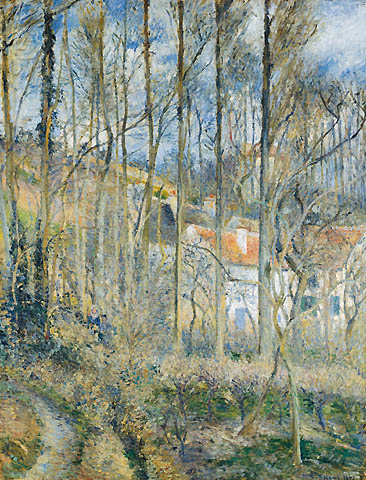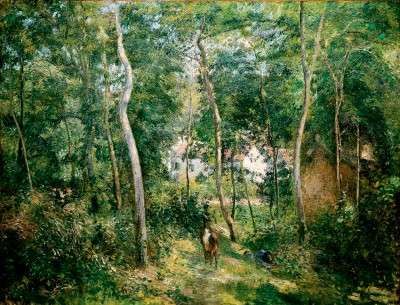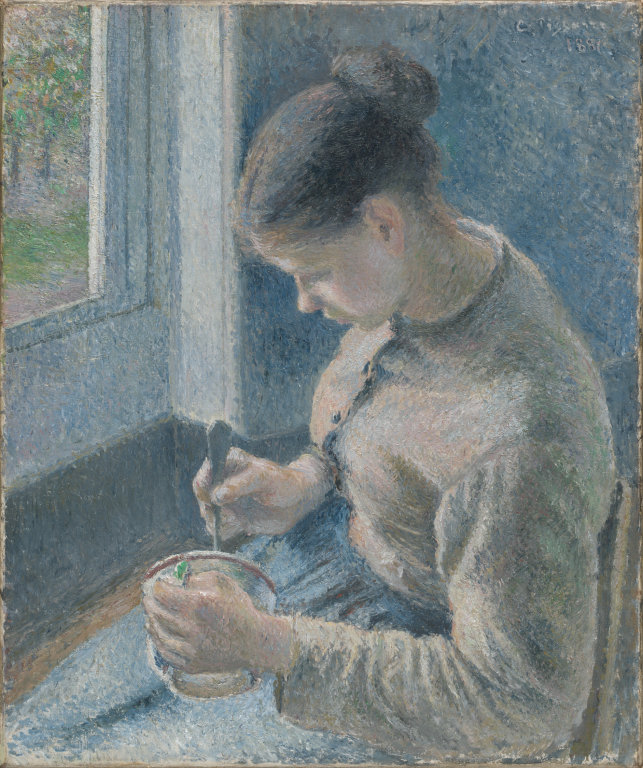IN PART 1, we discussed how changes in Paris in the mid-1800's led to the crisis of the "modern" world. We now turn to how a group of artists addressed the cultural problems, and provided solutions.
Rise of the Impression
With the "modern" changes in Paris came artistic crisis. Not only had the physical structure of the city changed, but the new bourgeoisie population behaved differently and had different social values. With new wealth spreading to a broader portion of the population, leisure time became more democratic and widespread—and more visible. People weren't conducting tea parties behind closed doors, but were out at parks, on the street, in cafes. Their interactions were observable.
Moreover, it was not just the working classes who were rising up and being more visible. Because of the destruction of the medieval streets, criminals and prostitutes who used to be hidden away now had to operate in the open. These elements, now exposed, had to find ways to mingle with the population and advertise their services without being obvious to the police. How a shirt was buttoned or what type of ribbons were worn in the hair became important signals to those in the know, as ne'er do wells hid in plain sight.
The prior art of painting subjects standing in a drawing room didn't translate well into the new, fast paced world of a blossoming "middle class." No longer did such artworks capture the meaningful aspects of society or the people who mattered. Instead, a group of painters—including Claude Monet, Pierre-Auguste Renoir, Édouard Manet, and Camille Pissarro—became interested in capturing what was happening in this fast-paced, bustling Paris: a passing moment, the impression of what's happening, rather than a realistic, detailed depiction. Their concern was an expression of the emotion elicited by a moment, rather than showing a hyper-realistic, frozen scene.
Sound like Cartier-Bresson style street photography? That's because it is.
Putting it on Canvas
The Impressionist's subject matter is nature; the everyday life of everyday people; urban and rural settings—no moral or religious lessons, no classist portrayal of the haves for the have-nots to behold. For the impressionists, the moment of present action was not just as background, but a context for the human experience.
This perspective on life dictated the Impressionists' approach to painting. The Impressionists often worked en plein air, and were not concerned with defined lines, rules of perspective, or technical brushstrokes. But they were very concerned with giving the spectator a sense of being in the moment—of direct involvement. What the Impressionists realized was that our reaction to a scene doesn't depend upon hyperrealistic accuracy, but it does require optical accuracy. The Impressionists realized early on that in order to best communicate the emotion of an impression, the painting should mesh with the brain's optical expectations. As explained by Professor Paul Smith in his book, Impressionism: Beneath the Surface:
In a letter of September 1892, Pissarro advised [his son] Lucien that all he needed to be a successful painter were "persistence, will, and free sensations, free from everything but your own sensations." However, there was more than a whiff of rhetorical exaggeration to this advice, since Pissarro knew that his own style had changed considerably under the impact of ideas, and especially scientific ideas, that he had encountered over the years. For example, the marked shift towards more colourful paintings in the late 1870s is one that he said himself could be put down to his increasing understanding of the science of optics, and to the knowledge it gave him of what he should be seeing in the landscape. As he told Lucien in February 1887:
De Bellig . . . tells me that research in physics on colour and light can be of no more use to the artist than anatomy or the laws of optics . . . . By Jove! if I didn't know how colours behaved from the researches of [Eugene] Chevreul and other scientists, we [the Impressionists] would not have been able to pursue our study of light with so much confidence. I would not make a distinction between local colour and illumination, if science had not brought it to light. And same goes for complimentaries, contrast, etc.
The paintings Pissarro produced in the late 1870s and early 1880s bear this out. They show that he was seeing a rich diversity of colour phenomena in the motif, but of a kind to which only contemporary science might have alerted him. For instance, Pissarro is attentive to the way the local colour of an object (its normal hue) is modified by the light falling upon it. Thus, in Cotes, Saint-Denis everything is suffused by a silvery autumnal light, the product of warm sunlight and the blue top light that comes from the sky. In Edge of the Woods (1879) and Young Peasant Girl with a Stick or The Shepherdess (1881 []) much of the work is coloured blue by the same top light (where the sun fails to penetrate the thick canopy of trees). In Young Peasant Girl Drinking Coffee (1881[]) the sitter's face is coloured green by reflections from the grass and trees outside the window. And in many paintings of this period, Pissarro focuses on the way complementary colours—red and green, orange and blue most commonly—intensify one another's hue.
Painters like Monet and Pissarro approached the impressionist task the same way an attentive street photographer does: finding an interesting moment is the first half of the task, and the second half is to capture that moment with a mindfulness about how spectators expect to see a scene. Indeed, the Impressionists were committed to painting quickly, while maintaining direct observation of their subjects. They avoided studies or drawings, and went to great lengths to revisit natural settings in precisely the same conditions. For example:
Monet's letters of the period show that he had canvases ready to paint whatever the weather. Maupassant recalled that, in 1885, Monet set off to paint whatever subject he was currently working on "followed by his children and Madame Hoschedé, carrying his canvases, sometimes as many as five or six, representing the same subject at different times of day and with different effects. He took them up and put them aside in turn, according to the changes in the sky."



The twin goals of impression and an accurate depiction of the scene were the driving forces of Impressionism, and Gustave Caillebotte provided an important bridge between painting and street photography. His contributions will, however, be the subject of a later article. For now, we remain focused on the philosophy.
While Pissarro and Caillebotte spent time working on the technical aspects of how to draw a spectator's attention into the painting through understanding the visual-perceptual processes of the brain, artists like Degas were working on how to engage spectators' interest in a moment, and how to make that moment extend into time.
A brilliant example of this is Degas' Place de la Concorde. In it, Degas used several visual devices to depict a mystery scene, happened upon by the spectator. Professor Smith gives us the details:
Degas, in particular, seemed intent on expressing the sudden, unexpected, and opaque quality of the flaneur's experiences and encounters. In works such as Place de la Concorde, the "spectator in the picture" is a flaneur who has come upon a situation with no easy explanation: he finds himself confronted with an elegantly dressed man and what appear to be his children; but his wife is missing, and there are no clues as to why. Degas also emphasises the unexpected and bewildering quality of the experience by using an oblique viewpoint to express how the spectator has stumbled across the scene. In much the same way, the sharply cut-off left edge of the painting (which slices through the back of a passerby) gives the spectator a feeling that it is as uncomfortable as it is unexpected.
Place de la Concorde.
Degas's painting is an example of the ideal function of art, as succinctly described by Semir Zeki, as well as Matisse:
[T]he overall function of art is an extension of the function of the brain. . . . I shall thus define the general function of art as a search for the constant, lasting, essential and enduring features of objects, surfaces, faces, situations, and so on, which allows us to acquire knowledge not only about the particular object, or face, or condition represented on the canvas but to generalise from that to many other objects and thus acquire knowledge about a wide category of objects or faces. . . . It follows that one of the functions of art is an extension of the major function of the visual brain.
. . . . Essentially, this is what the brain does continually—sizing from the continually changing information reaching it the more essential one, distilling from successive views the essential character of objects and situations.
Semir Zeki (Professor, Wellcome Department of Cognitive Neurology, University College London), Art and the Brain, 1, 4.
Underlying this succession of moments which constitutes the superficial existence of things and being, and which is continually modifying and transforming them, one can search for a truer, more essential character, which the artist will seize so that he may give to reality a more lasting interpretation.
Henri Matisse, Notes d'un peintre, La Grande Review, LII, 24, pp 731-45. Reproduced in Flam, JD. (1978), Matisse on Art, Phaidon, Oxford.
Impressionism is an application of these principles: the people of Paris were daily confronting scenes which they couldn't make sense of, and didn't have time to contemplate. Degas gives us a scene which reflected that experience, but he also gives the gift of time: the spectator beholds the moment just as he or she would on the street, but because it is frozen there is now time to study it; to figure it out; to make sense of the event, or at least reach a satisfactory personal explanation.
Works like Place de la Concorde are relatively humanistic, being less dependent upon understanding the culture and social mores of the time. It's a painting that has lasting impact because even a spectator of today can perceive the tension and mystery, knowing that something is amiss and making the effort to determine what and why.
Other works are less humanistic, and serve as an example of not only the subtleties that can make an image complex and powerful, but the dangers of making images of "today" rather than images that are about the human condition. An example again comes from Degas:
One work that very clearly positions the spectator as a flaneur-detective is Degas's monotype Women on a Cafe Terrace, Evening (1877[]). We observe how the man at the right of the picture has just passed the group of prostitutes assembled on the cafe terrace for the purpose of soliciting. One commentator has suggested that he might have given a discreet signal to a woman who has vacated a chair. At any event, the woman second from the left appears to be rising from her seat perhaps to fill the space which gives her a better position nearer the street. Although nothing is certain about the scenario, it does draw the spectator into it as a flaneur-detective, and invites him to scrutinise the scene for any clues that its characters might let slip. . . . What is more, Degas positions the spectator in this picture so that he remains hidden from the people he observes, or at least they give no indication of responding to his presence. He therefore succeeds in carrying out his observations unseen - like Baudelaire's flaneur.
Women on a cafe terrace in the evening.
To appreciate Women on a Cafe Terrace requires knowing details of a particular point in the cultural and social history of Paris, as well as the subtle methods of communication used by people of the time. That's a lot to ask of a spectator even remotely removed in time, and so the painting's impact is diminished. Although an example of creating a rich moment full of time, Women on a Cafe Terrace is a caution against relying upon the subtleties you know as an artist and making presumptions about your spectators' knowledge.
NEXT, we will apply these concepts to photography.